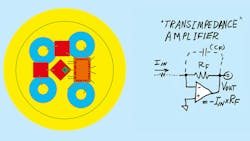Tailoring the Design of Transimpedance Amplifiers to Infrared Sensor Apps (Part 2) (Download)
High-speed optical communications applications have some high-level transimpedance-amplifier (TIA) circuit similarities with laser rangefinders (LRFs) and LiDAR. However, there are also many differences, especially at the product implementation level.
While LRFs and LiDAR generally require high linearity across the input dynamic range, a TIA designed for high-speed communications must amplify the incoming photocurrent and determine if a one or zero has been received to output the appropriate quantized digital value. Another major difference involves the bandwidths needed to support data rates of many gigabits and beyond, typically between 1 GHz and 40 GHz+, while still supporting transimpedance gains of many kilohms.
